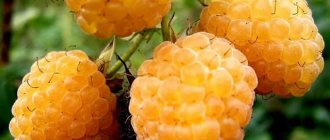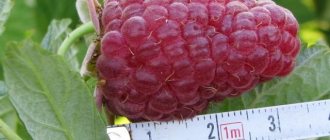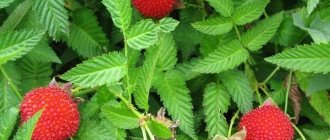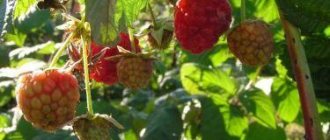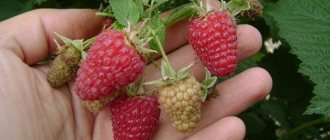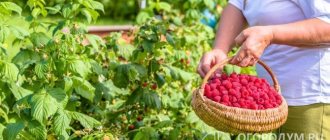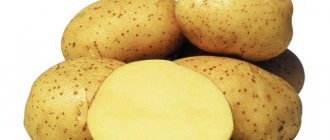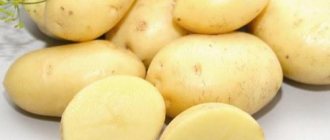Raspberry Zhuravlik is still not very common among gardeners. It’s strange, because the variety is distinguished by productivity, winter hardiness, good survival rate and other positive qualities. Basically, these varieties of berries can be found in all nurseries and specialty stores. Let’s correct the situation and tell you as much as possible about this remontant variety; perhaps you will like it.
Description of raspberry Crane
It is likely that the variety does not occupy the first position in the list of the most popular due to the fact that it appeared not so long ago. This raspberry was obtained in the Kokinsky stronghold of the State Scientific Institution VSTISP, by crossing varieties such as Kostinbrodskaya and Bulgarian Rubin.
The Zhuravlik raspberry was included in the State Register of Russia in 2001. It is zoned in the Middle Volga and North Caucasus regions. The originator also recommends the variety for testing in the Central region. When planting in cities with frostier winters, care should be taken to provide shelter.
The ripening period is early or mid-early, the variety bears fruit until the first significant frost. It is resistant to low temperatures and raspberry mites, and also has average immunity to various fungal diseases.
Characteristics of the bush and berries
The bush is medium in height, usually no higher than 2 meters, compact with average shoot formation (6–7 shoots per bush). The stems are straight, thickened, and have few thorns. Young shoots are purple with a faint waxy coating, two-year-old branches are light brown. The leaves are large, dark green, medium wrinkled, slightly curled. The pubescence is weakly expressed, small denticles are clearly visible along the edge.
The berries are universally used, reddish-ruby with slight pubescence, they are blunt-conical in shape, weighing up to 3.5 grams. The pulp is juicy, pleasant and very tender, sweet and sour. Gardeners who have tried the variety rate the taste 4.7 points out of 5. Ripe berries do not fall off, they hold tightly to the stalk. The seeds are small.
The average yield per bush is about 2 kilograms (about 20 centners per hectare of land).
Advantages
Raspberry Zhuravlik is a remontant variety. It has a good taste - tasting score 4.7 points, and decent yield. Among the positive qualities it is worth highlighting:
- Easy to care for.
- Excellent berry taste and decent yield.
- Resistance to diseases and pests.
- Suitable for growing in hot climates.
- Fruits until frost.
The crane is little susceptible to attacks by pests - its development periods do not coincide with the development phases of parasites.
The variety is zoned specifically for cultivation in the southern regions of Russia, in the North Caucasus, Middle Volga regions, as well as in the central and southern regions of Ukraine and Belarus.
More on the topic: Yellow raspberry variety Golden Queen
Positive qualities and disadvantages of the variety
Before moving on to the list of advantages, it is worth noting that the variety has no disadvantages. There are very minor disadvantages and there are very few of them, and they appear extremely rarely. Now let’s highlight all the best aspects of the Zhuravlik raspberry:
- long fruiting period;
- comfortable bush habit;
- unpretentiousness;
- the berries are tasty, they are good both fresh and in various processing;
- keeping quality and transportability;
- unpretentiousness;
- productivity;
- good immunity to diseases, pests and frost.
Raspberry Zhuravlik is more suitable for cultivation in small garden plots. For large areas, and especially for industrial farms, super-yielding varieties and hybrids are usually selected.
Harvesting and transportation
The first wave of harvesting begins towards the end of June. Since the berries have sufficient density, they are easy to transport over long distances. For transportation, it is better to use plastic containers in which raspberries are placed in layers. Each layer can be separated with parchment or a sheet of plain paper.
The berries retain their shape for a long time; it is advisable to store them in a cool and well-ventilated area. It is not advisable to transport berries in a plastic bag, as they will be subject to severe crushing. Moisture will accumulate in such a container, which will negatively affect the raspberries - they will begin to rot.
Sources:
https://ogorod-bez-hlopot.ru/malina-zhuravlik.html https://egemalina.ru/sorta/zhuravlik https://fermer.blog/bok/sad/malina/sorta-maliny/rannie-sorta- maliny/9502-malina-zhuravlik.html
Features of cultivation
Young seedlings are planted in the second half of September or until mid-April. The variety gives the best results when grown on enriched loams and sandy loams. Increased soil acidity is detrimental to raspberries. The plant is given a sunny area without the slightest shadow and strong winds.
The land for the raspberry garden is prepared long before planting. You need to dig up the soil, loosen it and apply fertilizer. At the initial stage, organic matter is used. Before planting, the bushes are carefully inspected; it is advisable to sort out all diseased plants and those with weak roots. If a significant part of the planting material has a dried rhizome, before sending it into the hole, it is recommended to dip the lower part of the bush in a mixture of water, clay and humus.
If the soil in the selected area is dry, raspberries are planted in deep trenches, and if the groundwater level is high, the bushes are placed on ridges or mounds. The stem cannot be buried; the root collar must remain at the level of the soil surface. The distance between seedlings is 50 cm, row spacing is about 2 meters. Provided that 2 bushes are planted in a hole, the row spacing is narrowed to one and a half meters.
Reproduction
The variety can be propagated by root suckers, cuttings and dividing the bush. All methods are very simple, even beginners can do them. Cuttings are carried out in the fall, sections of stems (10 cm each) are planted in prepared beds and watered abundantly, and young shoots grow in the spring.
Remontant raspberries produce few shoots; shoots mainly appear on bushes older than 4 years. In the spring they are dug up and planted in a temporary area for rooting, then moved to a permanent place.
How to care for the Zhuravlik raspberry variety
Mulching is carried out in early spring, as well as immediately after planting. The procedure helps retain moisture in the soil, protects the soil from erosion and serves as a preventive measure for certain pests and weeds. Mulching solves several issues at once, eliminates the need for loosening and weeding, and preserves the integrity of the root system.
What can be used as mulch:
- seed husks;
- nut shells;
- peat crumb;
- compost;
- chopped straw;
- crushed bark;
- rotted sawdust and shavings;
- straw manure;
- humus.
To compensate for the lack of nitrogen in the soil, the mulch can be treated with urea. The ground in raspberry fields is often covered with a special black film. Owners of sites with heavy soils and poor drainage should be warned. In this case, the soil should be left bare and loosened more often and it is advisable to add a little sand.
Raspberry Crane requires a garter; you can use any convenient method. The intensity of irrigation directly depends on the weather. Usually the raspberry tree is watered generously once a week, more often in hot weather, and in rainy seasons there is no need for additional moisture. Watering is especially important before the flowering period, when setting berries and during their filling.
Fertilizing is carried out in early spring when the buds open, 2 weeks before and during flowering, during fruiting, and also in the fall, after the last harvest. In the spring, nitrogen fertilizers are used, and then organic matter and mineral complexes.
Pruning and preparation for winter
In the case of remontant raspberries, the shoots are completely pruned (at the root) in the fall. But some gardeners also practice another method - they remove only half of the stem. The first option significantly reduces the risk of diseases and pests; insect larvae and fungal spores overwinter on the shoots.
Particularly complete cutting is good for cool regions; the procedure greatly simplifies the process of preparing raspberries for winter. Spruce branches, straw or hay are used as covering material; before the bushes are covered, they need to be hilled up. In cities with the coldest winters, the beds are additionally covered with agrofibre.
Planting and care, selection of seedlings
The place for the raspberry plant is chosen to be sunny, windless, with deep groundwater and normal soil pH. In case of high acidity, lime or dolomite flour is added to the soil. Tomatoes and garden strawberries should not be kept nearby; they share parasites and diseases.
You can cultivate raspberries in one place for up to 8 years, with ideal care, with high-quality fertilizer, a maximum of 10. In the future, soil reserves dry up, and pests and diseases multiply.
Preparing the site for planting raspberries
It is better to prepare the territory in advance, if planting is planned in the spring - in the fall, if in the fall - 1 month in advance. To properly prepare the area you need to:
- Remove all weeds - these are homes for diseases and parasites, as well as competitors for nutrients.
- Dig up the soil - improve the flow of air to the roots of future plants and destroy hidden parasites.
- Fertilize with humus, compost, and add mineral fertilizers.
- Prepare holes 40 by 40 cm wide and 30 cm deep.
In an area prepared in this way, raspberries do not need to be fertilized for 2-3 years; they will have enough nutrients. Gardeners will save a little on maintenance.
Planting raspberries
Raspberry seedlings, as a rule, take root well, the main thing is to choose them correctly. Nowadays, there is a huge selection of planting material in markets and stores. To avoid getting lost in the assortment, follow these rules:
- Buy seedlings from already verified agricultural farms or large stores that have quality certificates for their products.
- Do not buy plants without obvious varietal characteristics.
- Raspberries with open leaves will not survive, at most a “green cone”.
- The root system should look healthy without compaction, damage, neoplasms or fungal plaque. Root length from 15 cm.
- The shoot is 40 centimeters tall, smooth without cracks or new growths.
More on the topic: Remontant raspberries from Germany - Zefa Herbsternte
It is easier to prevent the introduction of parasites and fungal diseases into an area than to remove them later. The process of planting bushes is quite simple:
- Carefully place the raspberry stem in the prepared hole, straighten the roots so that there are no bends.
- Sprinkle with fertile soil and tamp down a little.
- Water the seedlings and sprinkle the resulting depressions, the root collar is level with the ground.
- Be sure to mulch (moss, straw, hay, peat, sawdust, etc.).
Thanks to mulch, moisture in the ground will remain longer and plants will take root and begin to develop faster. It will become more difficult for weeds to germinate, and weeding will be needed less often.
Planting scheme for the Zhuravushka variety:
The gaps between bushes in a row are from 70 cm to 1 meter, in row spacing - 1.5-2 meters.
Best time for planting: autumn. mid-late September, spring, first ten days of April.
Watering
In the future, Zhuravlik raspberries need regular watering. The main thing here is not to overdo it; excess moisture leads to soaking of the roots and death of the plants, as well as wateriness of the berries. The soil under the bushes should not dry out - the fruits will be dry and begin to crumble.
You can water in different ways:
- Under a bush.
- Sprinkling.
- Drip.
When watering under a bush, the water settles for 12 hours, the required amount is 8-10 liters per plant, the preferred watering time is evening.
Sprinkling - used in the morning or evening hours, this will prevent burns on the leaves.
Drip irrigation is best - it significantly saves time and water consumption, although it is a little expensive to organize.
Garter
Support for the Crane bushes is simply necessary. Thanks to the garter, the branches are illuminated from all sides by the sun, the berries will be tastier, and this is also an excellent disease prevention. Ultraviolet light actively destroys viruses and some fungi.
Good support helps preserve the harvest; branches do not break under its weight. The growth and development of young shoots improves.
More on the topic: Large-fruited raspberry Biryusinka
There are several ways to tie up Zhuravushka bushes:
- Kolovy.
- Single.
- Fan.
- Trellis.
The simplest and most frequently used is the stake method, also called the beam method. A peg or rail is driven into the center of the bush, and the stems are tied with twine.
The disadvantage of such a garter is poor ventilation and uneven penetration of sunlight, which increases the risk of developing viral and fungal diseases.
The best method is tying on a trellis, when each stem is fixed individually.
Fertilizer for raspberries of the Zhuravushka variety
In the spring, before the buds open, raspberries are fertilized with nitrogen fertilizers. Two weeks before flowering, it is better to use organic matter (rotted manure, chicken droppings). Subsequently, mineral complexes are used.
Trimming
Remontant varieties, including Zhuravlik raspberries, produce two fruitings - summer and autumn, but as a rule, they are grown for one large autumn harvest.
But you shouldn’t chase two birds with one stone; often the overall yield with double fruiting is less, since the first is usually delayed, and the second too. The main crop enters winter and suffers from frost.
The best option for pruning remontants is at the root. This method greatly simplifies maintenance, no bending or insulation is required in cold regions, and pest control is excellent. The cut stems are usually burned, along with all the parasite larvae.
Prevention of diseases and pests
If agricultural practices are followed, the Zhuravlik variety practically does not get sick. For gardeners who cannot often visit the dacha, it is advisable to carry out treatments with various protective drugs in the spring and autumn. The risk of fungal diseases increases during prolonged rainy periods, so raspberry fields are regularly weeded and the soil is loosened, and the bushes must be tied up.
If traces of various viruses are observed on some plants, they are removed from the beds; such ailments cannot be treated. Prevention of dangerous diseases will be the use of high-quality planting material and regular treatment of garden tools in disinfectants.
Raspberry Zhuravlik will definitely receive recognition - it’s a matter of time. Be sure to try this variety, it will not disappoint you. You'll see, after the first few years of growing you will begin to recommend it to all your friends!
Methods for growing raspberries
A gardener can grow Zhuravlik raspberries on a plot in several ways. The most common of them is dividing the bush: during the season the bush grows 6-7 shoots, which, if necessary, are dug up, divided and planted in separate holes.
In addition, raspberries can be propagated using root suckers, green or woody cuttings. When rooting, you need to make sure that the soil underneath does not dry out. Seed propagation is usually not used because it is labor-intensive and fruiting occurs after several years.
Reviews
Ilya. In 2002, I was at the exhibition of achievements at the Kokino Experimental Station and immediately purchased several Zhuravlik raspberry bushes. I fell in love with it from the very first year of cultivation - it is unpretentious, tasty, does not get sick and winters well. In the second year I started propagating the variety, now I have a large raspberry garden that pleases me with fresh berries until late autumn. I will continue to grow it and recommend it to everyone.
Irina. The plants are compact, the berries are very easy to pick, and when ripe they do not fall off and remain on the bushes for about 4 days. I live in the Leningrad region, I cover the raspberries with a small layer of straw for the winter, the Crane tolerates frosts well. I cut off the bushes completely; in the spring they grow back very quickly. A tasty variety that produces good yields of versatile berries. I bought seedlings at a high price and have never regretted this purchase.
Planting remontant raspberries Zhuravushka
Remontant raspberry
It is best to plant in spring (late April) or autumn (early October).
Seedlings are obtained in the following ways:
- root shoots;
- cuttings;
- dividing the bush.
Raspberries love areas that are well heated by the sun. In shaded areas, the harvest date is delayed and the taste of the berries is reduced. It is also necessary to take into account that bushes develop better in areas protected from the wind, for example, along a fence.
Growing raspberries near a fence
If groundwater is located at a depth of less than 1 m from the surface, then the planting site is chosen at higher elevations.
Light loamy or sandy loam soils are best suited for growing Zhuravushka raspberries. Therefore, before planting, you must check the pH level of the area. It should be between 5.8 and 6.7. If the soil is acidic, then first add 0.5 kg of lime per square meter.
It’s good if you first plant the garden with sederats (mustard, lupine, etc.). In 1.5 months. Before planting, the area with sederats is dug up.
For planting, trenches or holes are made 30-40 cm deep and 50-60 cm wide. The following planting pattern is followed: 0.7-1 m - row width and 1-1.5 m - between rows. This distance is maintained so that the raspberries can grow independently over time.
Humus, superphosphate, and wood ash are added to the prepared holes. If the soil is dense, add additional sand or peat. A bucket of humus and a glass of superphosphate and potassium sulfide are added per 1 sq.m. Instead, you can add 200-400 g of complex mineral fertilizer, also per 1 sq.m.
Attention! Before planting, fertilizers must be mixed with the soil so as not to damage the root system.
The varietal seedling is placed in a prepared hole so that the root collar is located at ground level. In sandy soil, it is allowed to be buried to a depth of no more than 4 cm.
Planting a seedling
After planting, be sure to water the bushes and trim the shoots to 25-30 cm.
How to grow the variety correctly?
Before planting the Crane on the site, you need to familiarize yourself with the peculiarities of its cultivation.
Time and place for landing
It is recommended to understand in advance the optimal timing for planting raspberry bushes in the garden. Gardeners living in southern regions with warm climates can plant in the fall. Planting work should be completed before the end of September, before the first nighttime drops in temperature begin. For people from northern regions, it is better to plant berries in the spring - in April or early May.
Having determined the timing of placement of raspberry seedlings, you need to choose a place for growing them. Raspberries should grow in areas that are not blown by northern winds and are well lit by the sun.
Preparation of seedlings
All remontant seedlings that will be planted in the garden must be prepared in advance. First you need to start pruning young raspberry seedlings. Experts advise cutting off bent and elongated roots so that the height of the plant does not exceed 30 centimeters.
Also, before planting, you need to carefully inspect the seedlings and make sure that they are not damaged.
During the inspection, special attention is paid to the root system. If the roots are too dark, it means they won't grow well.
Therefore, plants with light roots are selected for planting.
Planting scheme and process
Planting raspberries is carried out in several stages:
- Creating a landing hole. First, a hole is dug in the area in which the raspberries will be planted. The depth of the hole should not exceed 25 centimeters.
- Placement of seedlings. The young plant goes deep into the hole so that the growth point remains above the ground.
- Sprinkling with soil. The planted bush is sprinkled with soil mixed with fertilizers. Then a hole is made near the plant into which warm water is poured.
- Mulching. Planted raspberries are mulched with sawdust and fallen leaves.
What varieties are called remontant
All cultivated varieties have a lot of advantages, such as large fruit, productivity and others.
But those that produce more than one harvest per season are remontant. The word “Remontant” is translated as “bearing fruit without interruption.”
For the first time, remontant raspberry varieties were obtained more than two hundred years ago; since then, the number of varieties of such varieties has been constantly increasing. Breeders achieve the qualities they need, including suitability for growing in different climatic conditions.
Remontant varieties produce the first harvest on last year's shoots, like ordinary varieties, and the second - on the current year's shoots; it is this ability that is the main advantage of such varieties. But only gardeners in the southern regions of Russia, where it is still quite warm in October and the first half of November, can take full advantage and appreciate this opportunity. In the middle zone and northern latitudes, the second harvest of remontant raspberries of southern varieties simply will not have time to ripen.
Remontant raspberry varieties for the south of Russia, namely Kuban, Rostov region, North Caucasus and Crimea, are able to withstand short-term temperature drops to sub-zero values, while producing fruits even in mid-November.
Breeders have noticed that some varieties of remontant raspberries produce a smaller harvest in the fall than in the summer, while the berries are small and are inferior in taste to summer berries.
To achieve large berries in the fall, it is advisable to sacrifice the first harvest. In summer, it is better to get berries from regular varieties of raspberry bushes, and transfer the harvest from remontant varieties only to autumn. Some varieties are better suited to a two-year (two-harvest) growing cycle, while others are better suited to a one-year cycle. With the annual growing method, all fruit-bearing bushes of remontant raspberries are cut off at the root for the winter. In the spring, young shoots begin to grow and by autumn they can produce a bountiful harvest.
The advantage of this method is that pests and diseases will not accumulate in wintering shoots, so you will not have to use a lot of chemicals to destroy them.
The varieties most suitable for using the annual method are:
- darling;
- Chief Marshal;
- red guard;
- apricot;
- Augustine;
- white guard.
In principle, any variety of remontant raspberry can be grown in both an annual and biennial cycle, so each gardener will decide for himself which growing method he will choose.
